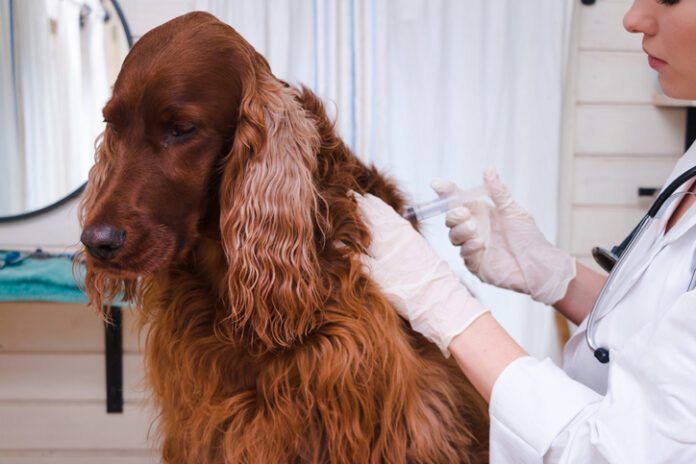In the November issue of WDJ, we published an article by a valued veterinary contributor regarding Librela, a new treatment for canine (and feline) osteoarthritis (“New Hope for Canine Osteoarthritis”), which became available for veterinarians to prescribe to their canine patients starting on November 1, 2023. The author has followed positive reports of the drug’s use since its approval for veterinarians to prescribe in Australia and in Europe about two years ago, and she’s used it in her own elderly cat with good results.
We’ve since received a few letters from readers who were concerned about our promotion of the drug, as each has been following reports in social-media groups from people whose dogs were given the drug. Some people report terrific results, but others report that their dogs experienced very bad and even fatal adverse reactions to the drug. I joined some groups I was able to locate on Facebook and have also been following some of these reports. These are my thoughts about the drug – and all new drugs that come onto the market:
I completely understand the enthusiasm of veterinarians for treatments that appear to offer benefits that exceed those of the competing treatments for painful, life-threatening conditions. Imagine feeling responsible for the well-being of countless patients who are in pain despite access to all the treatments currently available – and you hear about a new drug, one with a completely novel mode of action, with very good initial test results. You’d be excited and eager to hear more about it.
But I wouldn’t personally recommend jumping to be one of the first users of any new drug. Newly approved drugs may have been tested on relatively small numbers of animals – perhaps in the high hundreds or, at most, the low thousands – and the test subjects are unlikely to be afflicted with the number and variety of health problems (comorbidity) as the population of potential users of the drug. Often a drug needs to be given to a very large pool of patients before all the adverse side effects or contraindications – conditions under which the drug poses more harm than good – are discovered. And, personally, I wouldn’t be jumping to make my dogs these unwitting test subjects…. unless I was already using every other effective treatment, and they weren’t working. And unless my dog didn’t have any other serious health conditions, especially those that were being treated with other medications that hadn’t yet been evaluated yet for co-administration with the new drug. If my dog had Cushing’s syndrome, or cancer, or diabetes, or any other complex medical condition, forget it: I wouldn’t want to take a chance on something new and different.
That sounds selfish, I know. It is selfish. After all, unless someone is willing to try new drugs on their dogs, we’ll never find safe and effective (and better) new treatments.
But there has to be a balance. If my dog’s quality of life is poor, and the usual treatments are not working, heck, yes, I’d sign up to try a new and relatively untested but promising treatment. If it killed my dog, or made his condition worse, so that I ended up choosing to have him euthanized, I would feel terrible – and at the same time, glad that his life would have served to help other dogs. I’d want his adverse experience to be well-documented and reported to the FDA’s Center for Veterinary Medicine; I’d pay for a necropsy (animal autopsy), so anything that could be learned about the drug’s safety or lack of safety would be learned.
But if my dog’s symptoms are mild, and I have not yet exhausted the range of long-proven drugs with good safety records, I’d hold off on agreeing to try the revolutionary new medicine that my vet just mentioned to me.
Which brings me to the topic of the responsibility of our dogs’ doctors and our own responsibilities as our dogs’ guardians:
We pay our doctors to give us their best professional opinions, but ultimately, it’s up to us to decide whether to administer any recommended treatments. No doctor is infallible – and not all doctors are equally skilled or informed. It’s their professional responsibility to offer informed treatment – and ours to determine, to the best of our ability, how well informed that treatment is.
Any time a doctor recommends a treatment, we should be asking about the product’s history and safety, its contraindications and risks. If your vet isn’t sure or can’t immediately produce that information, or makes it sound like the product has no risks or contraindications, take a pass for that visit and do some investigating yourself. All drugs pose risks, and advice from any doctor who suggests otherwise shouldn’t be heeded.







Thank you for reaffirming my thoughts on treatment of my senior female Beagle. At 13 yrs old and having been with us for only 5 yrs, Macie is a 4 time cancer survivor. She is a treasure and the last cancer surgery took 1/2 a lung. I elected to forego subsequent chemo because I didn’t want the rest of her days to be spent trying to recover from chemo. I preferred to have her enjoy easy days and pleasurable moments in whatever time she had left. Well, I’m glad I made that decision – It has been a bit over a year since her last surgery and while we do see some decline in cognition and hearing, we also see lots of joy as she runs across the yard when her sisters are getting treats or petting sessions and she wants to be included. Her quality of life, right now could not be better and we are so happy to see her enjoyment every single day.
Roxy, my 14-year old Chow/Staffie/Golden mix, was limping badly from arthritis in hip and knee, restless, not eating, barely sleeping, even though she had been on Gabapentin and Carprovet for months. She appeared to be so miserable I compiled a list of vets who provide in-home euthanasia. I asked our regular vet to provide pain medication to make her as comfortable as possible in what I thought might be her last days. After two days on Librela and meloxicam she is walking normally, eating again, sleeping soundly and acting like her old self. However, thank you for your warning, I will be watching her closely for any bad side effects.
I find myself in complete agreement with your thoughts, Nancy. I think that prudence is wise when assessing the potential risks and benefits of starting your dog on a new medication.
However, I do want to point out that typically a very large percentage of reported adverse effects are literally coincidental. As you noted, many of the dogs being treated with novel drugs are not healthy and often at or near the end of their lives. The cliche that correlation is not causation needs to be kept in mind.